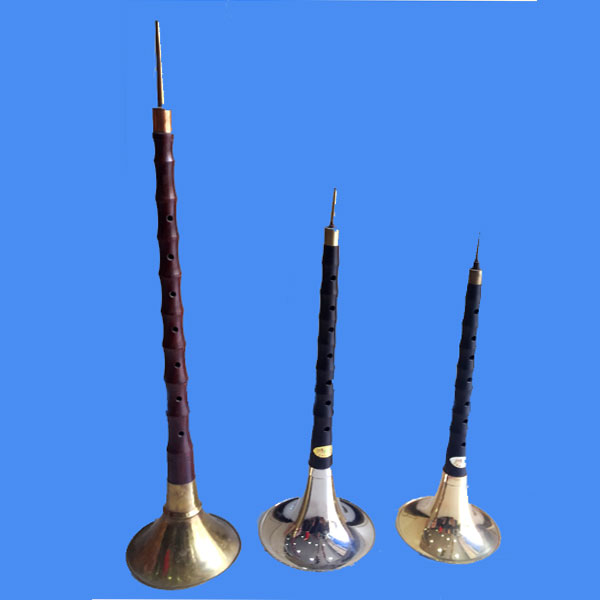Kèn bầu
Woodwinds
Asia
Between 1001 and 1900 AD
Video
The kèn bầu is a traditional Vietnamese double-reed wind instrument, notable for its unique construction and sound. It plays a significant role in various musical traditions throughout Vietnam, particularly in the royal court music of Huế.
Historical Background
The kèn bầu has been a part of Vietnamese music for centuries, particularly associated with the royal court music of Huế. While exact dates of its origin are unclear, it is believed to have developed in Vietnam during the 14th century. Historical records indicate that it was used in ceremonial contexts and public performances, often accompanying other traditional instruments.
Etymology
The term “kèn” translates to “oboe,” while “bầu” refers to “gourd,” highlighting the instrument’s distinctive bell shape. This nomenclature reflects its construction and the cultural significance of its sound.
Cultural Significance
Throughout its history, the kèn bầu has been integral to various Vietnamese cultural practices:
It was prominently featured in the nhã nhạc (royal music) of Huế, where it played a key role in ceremonies and royal events. The kèn bầu is also associated with folk music, often performed during festivals and communal gatherings. It has been used to accompany traditional dances and storytelling. In contemporary times, the kèn bầu has seen adaptations in orchestras and modern music ensembles, showcasing its versatility beyond traditional contexts.
Construction
The kèn bầu features a conical body made from hardwood, typically with seven finger holes that allow for a range of pitches. A notable characteristic is its detachable bell, traditionally made from jackfruit wood, shaped like a gourd. The instrument is played using a small double reed fitted onto a brass tube at one end.
Key Features
- Material: Hardwood body with a jackfruit wood bell.
- Finger Holes: Seven holes for pitch variation.
- Reed: A small double reed is fitted onto a brass tube at the playing end.
Playing Technique
Playing the kèn bầu requires mastery of specialized techniques to produce its distinctive, emotive sound. Musicians use a tight embouchure to control the double reed and employ circular breathing, a technique that allows continuous airflow by simultaneously inhaling through the nose while using stored air in the cheeks to blow into the instrument. The seven finger holes are manipulated with precision for pitch control, often incorporating sliding motions and pitch bending for expressive ornamentation. Wide vibrato, trills, and grace notes are common, adding to the lyrical and vocal-like quality of the sound. Dynamic control, achieved through variations in breath pressure, allows the player to produce both soft, mellow tones and loud, penetrating notes, making the kèn bầu a versatile and emotionally rich instrument central to Vietnamese traditional music.
Performance Context
The kèn bầu is often accompanied by percussion instruments such as drums and gongs, creating a rich auditory experience during performances. It has historically been used outdoors for public announcements and celebrations due to its loud and directional sound.
Prominent Players
The kèn bầu, as a traditional Vietnamese wind instrument, has been upheld by a lineage of skilled musicians, many of whom are integral to preserving and advancing Vietnam’s rich musical heritage. Here are some notable players and contributors to the kèn bầu tradition.
Famous Compositions Featuring the Kèn bầu
Nhã Nhạc (Royal Court Music)
The Kèn bầu is a prominent instrument in Nhã Nhạc, the traditional royal court music of Vietnam. This genre includes various compositions performed during ceremonial occasions, showcasing the Kèn bầu’s expressive capabilities alongside other traditional instruments.
Tam Quốc Tây Du (The Three Kingdoms Journey to the West)
This composition is often played during royal ceremonies and celebrations, where the Kèn bầu contributes to the majestic soundscape that accompanies significant events in Vietnamese history.
Mu (Ceremonial Music)
The Kèn bầu features prominently in Mu, a type of ceremonial music used for worshipping ceremonies and important celebrations, highlighting its role in traditional Vietnamese rituals.
Thien Xuan (Heavenly Spring)
This piece is performed during ceremonies for wealthy individuals and powerful figures, utilizing the Kèn bầu to evoke a sense of grandeur and reverence appropriate for such occasions.
FAQ
How is the Kèn bầu Constructed?
The Kèn bầu is constructed from hardwood, typically featuring a cylindrical bore that leads to a gourd-shaped bell. It has seven finger holes on the front and one thumb hole, allowing for a range of pitches over an octave.
What Techniques Are Used to Play the Kèn bầu?
Playing the Kèn bầu involves techniques such as circular breathing, which allows musicians to produce continuous sound without interruption. Performers also utilize various ornamentation techniques, including wide vibrato and sliding tones, to enhance expressiveness.
What are some famous compositions that feature the Kèn bầu?
The Kèn bầu is featured prominently in various traditional Vietnamese compositions, particularly within the realm of Nhã Nhạc, the royal court music of Vietnam. This genre includes a range of ceremonial pieces performed during significant events, such as royal celebrations and religious ceremonies.
 Links
Links
References
Other Instrument
Categories


















